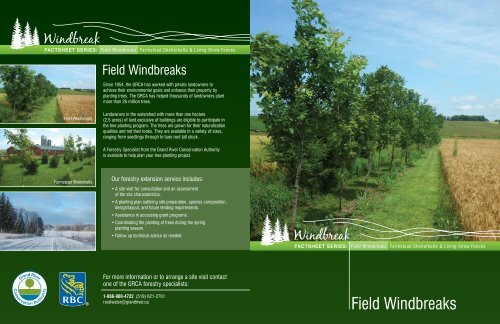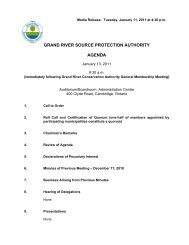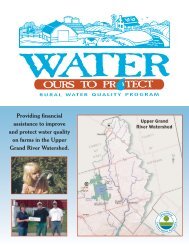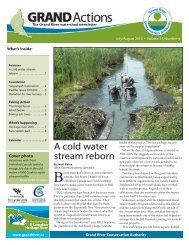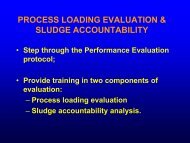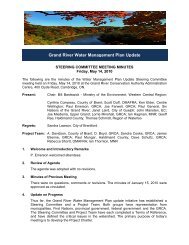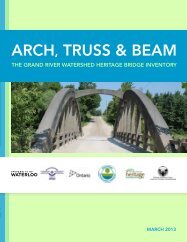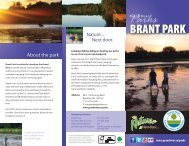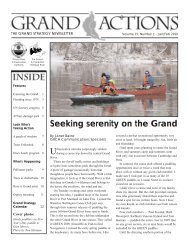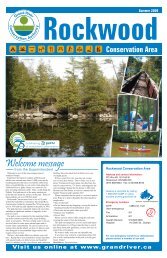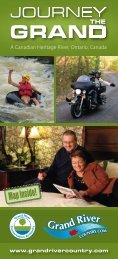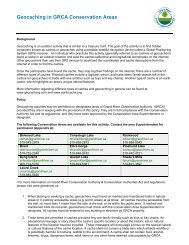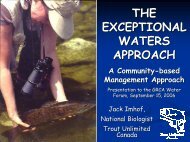Windbreak Factsheet series - Grand River Conservation Authority
Windbreak Factsheet series - Grand River Conservation Authority
Windbreak Factsheet series - Grand River Conservation Authority
Create successful ePaper yourself
Turn your PDF publications into a flip-book with our unique Google optimized e-Paper software.
<strong>Windbreak</strong><br />
FACTSHEET SERIES: Field <strong>Windbreak</strong>s, Farmstead Shelterbelts & Living Snow Fences<br />
Field <strong>Windbreak</strong>s<br />
Field <strong>Windbreak</strong>s<br />
Since 1954, the GRCA has worked with private landowners to<br />
achieve their environmental goals and enhance their property by<br />
planting trees. The GRCA has helped thousands of landowners plant<br />
more than 26 million trees.<br />
Landowners in the watershed with more than one hectare<br />
(2.5 acres) of land exclusive of buildings are eligible to participate in<br />
the tree planting program. The trees are grown for their naturalization<br />
qualities and not their looks. They are available in a variety of sizes,<br />
ranging from seedlings through to bare root tall stock.<br />
<strong>Windbreak</strong><br />
FACTSHEET SERIES: Field <strong>Windbreak</strong>s, Farmstead Shelterbelts & Living Snow Fences<br />
A Forestry Specialist from the <strong>Grand</strong> <strong>River</strong> <strong>Conservation</strong> <strong>Authority</strong><br />
is available to help plan your tree planting project.<br />
Farmstead Shelterbelts<br />
Living Snow Fences<br />
Our forestry extension service includes:<br />
• A site visit for consultation and an assessment<br />
of the site characteristics.<br />
• A planting plan outlining site preparation, species composition,<br />
design/layout, and future tending requirements.<br />
• Assistance in accessing grant programs.<br />
• Coordinating the planting of trees during the spring<br />
planting season.<br />
• Follow up technical advice as needed.<br />
<strong>Windbreak</strong><br />
FACTSHEET SERIES: Field <strong>Windbreak</strong>s, Farmstead Shelterbelts & Living Snow Fences<br />
<strong>Windbreak</strong><br />
FACTSHEET SERIES: Field <strong>Windbreak</strong>s, Farmstead Shelterbelts & Living Snow Fences<br />
For more information or to arrange a site visit contact<br />
one of the GRCA forestry specialists:<br />
1-866-900-4722 (519) 621-2761<br />
ruralwater@grandriver.ca<br />
Field <strong>Windbreak</strong>s
Single Row Spruce <strong>Windbreak</strong><br />
Prevailing<br />
Wind Direction<br />
Single row<br />
of spruce at<br />
2m spacing<br />
Objectives<br />
• Improve crop yield.<br />
• Shelter farmstead from harsh winds.<br />
• Use a row of trees to define property line.<br />
Strategy<br />
Field<br />
<strong>Windbreak</strong>s<br />
Strategically plant rows of trees adjacent to your farm fields to increase crop yields by slowing the wind<br />
and reducing moisture loss in plants and soil. You will also prevent erosion, increase pollinator habitat,<br />
provide wildlife corridors, increase snow deposition for added soil moisture, provide perching sites for<br />
raptors to decrease rodent populations and supplement farm income through forest products.<br />
Living<br />
Snow Fences<br />
Farmstead<br />
Shelterbelts<br />
• Install plastic mulch prior to planting<br />
for weed control and moisture retention.<br />
• Hand plant a single row of white spruce<br />
seedlings at 2m spacing.<br />
Planting<br />
Three Row Conifer <strong>Windbreak</strong><br />
Prevailing<br />
Wind Direction<br />
Three rows at<br />
2m spacing<br />
between trees<br />
and 3m spacing<br />
between rows.<br />
Outside row:<br />
cedar<br />
Middle row:<br />
pine/spruce<br />
Outside row:<br />
cedar<br />
Objectives<br />
• To protect against GMO contamination<br />
and spray drift from neighbouring farms<br />
for organic farm certification.<br />
• Improve crop yield.<br />
• Provide wildlife corridor.<br />
Strategy<br />
• Hand plant a three row windbreak at<br />
a spacing of 2m between trees and<br />
3m between rows.<br />
• The two outside rows consist of cedar.<br />
The middle row consists of a mix of pine<br />
and spruce.<br />
• The middle row of spruce and pine will<br />
have every second tree removed and<br />
transplanted to other areas on the farm<br />
when crowns begin to touch.<br />
Double Row Conifer & Hardwood <strong>Windbreak</strong><br />
Year 2<br />
Year 20<br />
Objectives<br />
Year 3<br />
Prevailing<br />
Wind Direction<br />
• Aesthetics.<br />
• Improve crop yield.<br />
• Provide wildlife corridor.<br />
Single Row Hardwood <strong>Windbreak</strong><br />
Single row<br />
alternating<br />
between<br />
maple and ash<br />
at 2m<br />
spacing<br />
Prevailing<br />
Wind Direction<br />
Objectives<br />
• Aesthetics.<br />
• Wildlife enhancement.<br />
• Improve crop yield.<br />
Strategy<br />
• Hand plant a single row of hardwood<br />
saplings (5-6 foot, bare root stock).<br />
• Alternate between green ash and sugar<br />
maple at 2m spacing.<br />
• The faster growing green ash will eventually<br />
be thinned out, to allow for a well spaced<br />
row of sugar maple. The initial planting of<br />
ash trees between the maples allows the<br />
crowns to touch and achieve the desired<br />
porosity sooner. Once the ash trees are<br />
removed, shrubs can be planted between<br />
the maples to attain desired windbreak<br />
porosity from top to bottom.<br />
Year 2<br />
Year 5<br />
Spruce at<br />
2m spacing<br />
Prevailing wind direction<br />
<strong>Windbreak</strong><br />
height = 30 ft<br />
Mix of<br />
deciduous at<br />
2m spacing<br />
Zone of decreased crop yield<br />
25-50%<br />
of open field<br />
wind velocity<br />
Strategy<br />
• Hand plant a double row windbreak at<br />
2m spacing between trees and 3m spacing<br />
between rows.<br />
• The first row on the west side consists<br />
of spruce.<br />
• The second row consists of a mix of maple<br />
and oak.<br />
• The row of spruce will serve the function<br />
of providing wind protection while the second<br />
row will add more wildlife and aesthetic value.<br />
<strong>Windbreak</strong> protection zones and crop yields*<br />
200 ft 400 ft 600 ft<br />
Zone of increased crop yield<br />
50-70%<br />
of open field<br />
wind velocity<br />
*Distances and figures are approximate. Vertical scale exaggerated.<br />
70-80%<br />
of open field wind velocity<br />
Average crop yield<br />
Year 7
<strong>Windbreak</strong><br />
FACTSHEET SERIES: Field <strong>Windbreak</strong>s, Farmstead Shelterbelts & Living Snow Fences<br />
Farmstead Shelterbelts<br />
Since 1954, the GRCA has worked with private landowners to<br />
achieve their environmental goals and enhance their property by<br />
planting trees. The GRCA has helped thousands of landowners plant<br />
<strong>Windbreak</strong> more than 26 million trees.<br />
FACTSHEET SERIES: Field <strong>Windbreak</strong>s, Farmstead Shelterbelts & Living Snow Fences<br />
Landowners in the watershed with more than one hectare<br />
Field <strong>Windbreak</strong>s (2.5 acres) of land exclusive of buildings are eligible to participate in<br />
the tree planting program. The trees are grown for their naturalization<br />
qualities and not their looks. They are available in a variety of sizes,<br />
ranging from seedlings through to bare root tall stock.<br />
Farmstead Shelterbelts<br />
Living Snow Fences<br />
A Forestry Specialist from the <strong>Grand</strong> <strong>River</strong> <strong>Conservation</strong> <strong>Authority</strong><br />
is available to help plan your tree planting project.<br />
Our forestry extension service includes:<br />
• A site visit for consultation and an assessment<br />
of the site characteristics.<br />
• A planting plan outlining site preparation, species composition,<br />
design/layout, and future tending requirements.<br />
• Assistance in accessing grant programs.<br />
• Coordinating the planting of trees during the spring<br />
planting season.<br />
• Follow up technical advice as needed.<br />
<strong>Windbreak</strong><br />
FACTSHEET SERIES: Field <strong>Windbreak</strong>s, Farmstead Shelterbelts & Living Snow Fences<br />
<strong>Windbreak</strong><br />
FACTSHEET SERIES: Field <strong>Windbreak</strong>s, Farmstead Shelterbelts & Living Snow Fences<br />
For more information or to arrange a site visit contact<br />
one of the GRCA forestry specialists:<br />
1-866-900-4722 (519) 621-2761<br />
ruralwater@grandriver.ca<br />
<strong>Windbreak</strong><br />
Farmstead<br />
Shelterbelts<br />
FACTSHEET SERIES: Field <strong>Windbreak</strong>s, Farmstead Shelterbelts & Living Snow Fences
Snow Fences<br />
Single Row Hardwood Shelterbelt<br />
Three Row Mixed Species Shelterbelt<br />
Prevailing<br />
Wind Direction<br />
Objectives<br />
• Decrease barn heating costs.<br />
• Reduce odour from hog barn.<br />
• Aesthetics.<br />
Strategy<br />
• Install plastic mulch prior to planting<br />
for weed control and moisture retention.<br />
• Hand plant a three row windbreak at<br />
3m spacing.<br />
• The outside row consists of spruce.<br />
• The middle row consists of poplar.<br />
• The inside row consists of a mix<br />
of hardwoods and shrubs.<br />
• The faster growing poplars will provide<br />
wind protection sooner in the life span of<br />
the shelterbelt. The middle poplar row may<br />
be thinned out once the spruces are large<br />
enough to provide wind protection for the<br />
barn. The mixed hardwood and shrub row<br />
provides aesthetics and biodiversity.<br />
Three Row Conifer & Hardwood Shelterbelt<br />
Prevailing<br />
Wind Direction<br />
Three row<br />
Shelterbelt<br />
Outside row:<br />
spruce<br />
Middle row:<br />
poplar<br />
Inside row:<br />
hardwoods<br />
and shrubs<br />
Two rows<br />
of spruce at<br />
3m x 3m<br />
spacing<br />
Objectives<br />
Farmstead<br />
Shelterbelts<br />
Surrounding your farmstead with trees is a good investment, reducing energy costs<br />
and improving livestock health.<br />
• Decrease barn heating costs.<br />
• Aesthetics.<br />
Planting Day<br />
Planting Day<br />
Year 3<br />
Planting Day<br />
Prevailing<br />
Wind Direction<br />
Single row<br />
Prevailing wind alternating direction<br />
between maple<br />
and poplar at<br />
2m spacing<br />
<strong>Windbreak</strong><br />
height = 30 ft<br />
Zone of decreased crop yield<br />
25-50%<br />
of open field<br />
wind velocity<br />
Objectives<br />
• Decrease barn heating and cooling costs.<br />
• Aesthetics.<br />
Strategy<br />
• Hand plant a single row of hardwood<br />
saplings (5-6 foot, bare root stock).<br />
• Alternate between soft maple and polar<br />
at 2m spacing.<br />
• The faster growing poplars will eventually<br />
be thinned out, to allow for a well spaced<br />
row of maples. The initial planting of<br />
poplar trees between the maples allows<br />
the crowns to touch and achieve the<br />
desired porosity sooner.<br />
• Once the trees reach maturity, their<br />
<strong>Windbreak</strong> protection zones and crop yields*<br />
Double Row Conifer and Hardwood Shelterbelt<br />
Prevailing wind direction<br />
crowns will provide shade<br />
50-70%<br />
to cool the<br />
poultry barn from the of open hot sun field and<br />
70-80%<br />
decrease cooling costs. wind velocity<br />
of open field wind velocity<br />
200 ft 400 ft 600 ft<br />
Year 5<br />
Zone of increased crop yield<br />
Average crop yield<br />
Objectives<br />
Designing a living snow fence that will effectively trap snow*<br />
Inside row:<br />
Prevailing<br />
Wind Direction<br />
• Protect livestock from harsh winds.<br />
• Aesthetics.<br />
Strategy<br />
White spruce<br />
• Hand plant a double row windbreak at<br />
at 4m Mature height<br />
4m spacing between trees and 4m spacing<br />
spacing = 10 meters<br />
between rows.<br />
10 meters 20 meters 30 meters<br />
• The inside row consists of white spruce.<br />
Plan ahead and consider the height of the trees at maturity.<br />
Snow accumulation area<br />
• The outside row consists of sugar maple.<br />
As a general rule of thumb, the snow will be deposited on the leeward<br />
side of the Outside row of row: trees for a distance of 3 times the height • of The the trees. spruce row will protect the livestock from<br />
Sugar maple<br />
at 4m<br />
harsh winds, while the maple row provides<br />
spacing<br />
enhanced aesthetics.<br />
*Distances and figures are approximate. Vertical scale exaggerated.<br />
*Distances and figures are approximate, there are variations<br />
to this rule depending on wind speeds, the topography and<br />
the density of the trees.<br />
Road or laneway<br />
Year 1<br />
Year 3<br />
One row of<br />
maple at 5m<br />
spacing<br />
Strategy<br />
• Hand plant a three row windbreak of 2 foot<br />
potted spruces and 5 foot sapling maples.<br />
• The two inside rows consist of white spruce<br />
at 3m spacing. Spacing is staggered<br />
to optimize wind protection for the barn.<br />
• The outside row consists of sugar maple<br />
at 5m spacing.<br />
• The spruce rows are to provide optimal<br />
wind protection while the maple row<br />
provides enhanced aesthetics.<br />
Year 2<br />
Year 4<br />
<strong>Windbreak</strong> protection to reduce heating cost and protect livestock*<br />
Prevailing wind direction<br />
Plant multiple rows<br />
Plant a diverse mix of species,<br />
including deciduous trees and shrubs<br />
30%<br />
reduction in<br />
air conditioning<br />
25%<br />
reduction in<br />
heating costs<br />
*Figures are approximate, there are variations<br />
to this rule depending on wind speeds, the<br />
topography and the density of the trees.<br />
Improved<br />
livestock health<br />
Establish a shelterbelt around fileds to protect<br />
livestock from harsh winter winds
<strong>Windbreak</strong><br />
FACTSHEET SERIES: Field <strong>Windbreak</strong>s, Farmstead Shelterbelts & Living Snow Fences<br />
<strong>Windbreak</strong><br />
Living Snow Fences<br />
Since 1954, the GRCA has worked with private landowners to<br />
achieve their environmental goals and enhance their property by<br />
planting trees. The GRCA has helped thousands of landowners plant<br />
more than 26 million trees.<br />
FACTSHEET SERIES: Field <strong>Windbreak</strong>s, Farmstead Shelterbelts & Living Snow Fences<br />
Landowners in the watershed with more than one hectare<br />
Field <strong>Windbreak</strong>s (2.5 acres) of land exclusive of buildings are eligible to participate in<br />
the tree planting program. The trees are grown for their naturalization<br />
qualities and not their looks. They are available in a variety of sizes,<br />
ranging from seedlings through to bare root tall stock.<br />
<strong>Windbreak</strong><br />
A Forestry Specialist from the <strong>Grand</strong> <strong>River</strong> <strong>Conservation</strong> <strong>Authority</strong><br />
is available to help plan your tree planting project.<br />
FACTSHEET SERIES: Field <strong>Windbreak</strong>s, Farmstead Shelterbelts & Living Snow Fences<br />
Farmstead Shelterbelts<br />
Living Snow Fences<br />
Our forestry extension service includes:<br />
• A site visit for consultation and an assessment<br />
of the site characteristics.<br />
• A planting plan outlining site preparation, species composition,<br />
design/layout, and future tending requirements.<br />
• Assistance in accessing grant programs.<br />
• Coordinating the planting of trees during the spring<br />
planting season.<br />
• Follow up technical advice as needed.<br />
<strong>Windbreak</strong><br />
FACTSHEET SERIES: Field <strong>Windbreak</strong>s, Farmstead Shelterbelts & Living Snow Fences<br />
For more information or to arrange a site visit contact<br />
one of the GRCA forestry specialists:<br />
1-866-900-4722 (519) 621-2761<br />
ruralwater@grandriver.ca<br />
<strong>Windbreak</strong><br />
Living<br />
Snow<br />
Fences<br />
FACTSHEET SERIES: Field <strong>Windbreak</strong>s, Farmstead Shelterbelts & Living Snow Fences
<strong>Windbreak</strong>s<br />
Single Row Spruce Living Snow Fence<br />
Living<br />
Snow Fences<br />
Objectives<br />
• Decrease snow drifts on the road.<br />
• Improve winter driving safety.<br />
Double Row Cedar Living Snow Fence<br />
Prevailing<br />
Wind Direction<br />
Improve winter driving safety and reduce snow removal costs by using<br />
a strip of trees to trap the snow blowing across open fields.<br />
Objectives<br />
Farmstead<br />
Shelterbelts<br />
• Decrease snow drifts on the road.<br />
• Improve winter driving safety.<br />
• Improve crop yields.<br />
Prevailing<br />
Wind Direction<br />
Single row<br />
of spruce<br />
at 2.5m<br />
spacing<br />
• Improve crop yields.<br />
Strategy<br />
• Hand plant one row of 2 foot potted<br />
white spruce at 2.5m spacing.<br />
• The row of trees is set back 40m<br />
from the road.<br />
• Leave a 10m gap on both ends for<br />
equipment access.<br />
Strategy<br />
Year 1<br />
Double row<br />
of cedar at<br />
1.5m x 1.5m<br />
spacing<br />
• Hand plant a double row of 1m tall, balled<br />
and burlapped cedars spaced 1.5m apart.<br />
• The first row on the windward side is set<br />
back 35m from the road.<br />
Five Row Mixed Species Living Snow Fence<br />
Prevailing<br />
Wind Direction<br />
Objectives<br />
Three Row Spruce Living Snow Fence<br />
Prevailing<br />
Wind Direction<br />
Objectives<br />
• Decrease snow drifts on the laneway.<br />
• Decrease snow removal costs.<br />
Strategy<br />
• Hand plant three rows of white spruce<br />
seedlings at 2m spacing between trees<br />
and 2m spacing between rows.<br />
• The first row on the windward side<br />
is set back 30m from the laneway.<br />
• Leave a 10m gap on both ends for<br />
equipment access.<br />
Year 14<br />
Five rows at<br />
Prevailing 2m wind x 3m direction<br />
spacing<br />
Row 2:<br />
Poplar<br />
<strong>Windbreak</strong><br />
Row 3:<br />
height = 30 ft<br />
Green ash,<br />
silver maple<br />
Row 4:<br />
Zone White of spruce decreased crop yield<br />
Row 5<br />
(inside row):<br />
Red oak<br />
• Decrease snow drifts on the laneway.<br />
• Decrease snow removal costs.<br />
<strong>Windbreak</strong> protection zones and crop yields*<br />
Row 1<br />
(outside row):<br />
Poplar<br />
Prevailing wind direction<br />
Strategy<br />
• Hand plant five rows of seedlings at 2m<br />
*Distances and figures are approximate. Vertical scale exaggerated.<br />
spacing between trees and 3m spacing<br />
between rows.<br />
• The outside two rows consist of poplars.<br />
25-50% • Row three consists of 50-70% a mix of green ash<br />
of open field<br />
of open field<br />
70-80%<br />
wind velocity<br />
and silver maple.<br />
wind velocity<br />
of open field wind velocity<br />
• Row four 200 consists ft of white spruce.<br />
400 ft 600 ft<br />
• Row five consists of red oak.<br />
Zone of increased crop yield<br />
Average crop yield<br />
• The first row on the windward side<br />
is set back 35m from the laneway.<br />
Designing a living snow fence that will effectively trap snow*<br />
*Distances and figures are approximate, there are variations<br />
to this rule depending on wind speeds, the topography and<br />
the density of the trees.<br />
Year 1<br />
Year 5<br />
Three rows<br />
of spruce<br />
at 2m x 2m<br />
spacing<br />
Mature height<br />
= 10 meters<br />
10 meters 20 meters 30 meters<br />
Year 20<br />
Plan ahead and consider the height of the trees at maturity.<br />
As a general rule of thumb, the snow will be deposited on the leeward<br />
side of the row of trees for a distance of 3 times the height of the trees.<br />
Snow accumulation area<br />
Road or laneway


